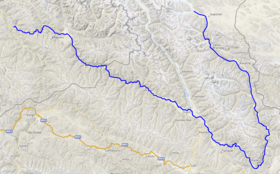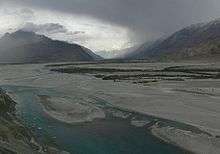Shyok River
The Shyok River (lit. 'the river of death')[1] a tributary of the Indus River that flows through northern Ladakh and enters Gilgit–Baltistan, spanning some 550 km (340 mi).
| Shyok River | |
|---|---|
 Shyok river | |
 Course of the Shyok | |
| Etymology | "the river of death"[1] |
| Location | |
| Country | India, Pakistan |
| State / Region | Ladakh (India), Gilgit-Baltistan (Pakistan) |
| District / Division | Leh (India), Baltistan (Pakistan) |
| Physical characteristics | |
| Source | |
| • coordinates | 35.35°N 77.62°E |
| Mouth | |
• coordinates | 35.23°N 75.92°E |
| Basin features | |
| River system | Indus River |


The Shyok River originates at the Rimo Glacier, one of the tongues of Siachen Glacier. The alignment of the Shyok river is very unusual, originating from the Rimo glacier, it flows in a southeasterly direction and, joining the Pangong range, it takes a northwestern turn, flowing parallel to its previous path. The Shyok valley widens at the confluence with the Nubra River but suddenly turns into a narrow gorge near Yagulung (34.77°N 77.14°E), continuing through Bogdang, Turtuk[2] and Tyakshi before crossing into Baltistan. The river joins the Indus at Keris, east of the town of Skardu.[3][4]
The Nubra river, originating from the Siachen glacier, also behaves like the Shyok. Before Tirkit, the SE flowing river Nubra takes a NW turn on meeting the river Shyok. The similarity in the courses of these two important rivers probably indicates a series of paleo fault lines trending NW-SE in delimiting the upper courses of the rivers. The importance of the Indus and the Shyok rivers is in the deposition of the thick Quaternary sediments—a treasure trove for geology researchers.
Shyok valley
The Shyok Valley is the valley of the Shyok River situated in Ladakh. The valley is close to the Nubra Valley. Khardung La on the Ladakh Range lies north of Leh and is the gateway to the Shyok and Nubra valleys. The Siachen Glacier lies partway up the latter valley.
Tributaries
- The Chang Chen Mo River is formed in the vicinity of Pamzal in Changchinmo plains of Ladakh and flows westward. It ends when it empties into the Shyok River.
- The Galwan River is in the southern part of Aksai Chin, Galwan originates in the area of Samzungling and flowing to the west joins the Shyok River.
- The Nubra River is a tributary of the Shyok River, which flows into the Indus River. It flows in the Ladakh region of India.
- The Saltoro River begins in the skirts of the Saltoro Kangri peak ridge and flows to the southwest. Another branch starts from the slopes of the Masherbroom peak and flows to the south to join Saltoro. In the end this river empties into Shyok River near the town of Khaplu.
Gallery
 Shyok in Khaplu Valley
Shyok in Khaplu Valley Kharfaq and Yugu
Kharfaq and Yugu Road marker map
Road marker map
See also
References
- Sharad Singh Negi: Himalayan Rivers, Lakes, and Glaciers. Indus Publishing 1991, ISBN 81-85182-61-2
- H. N. Kaul: Rediscovery of Ladakh. Indus Publishing 1998, ISBN 81-7387-086-1, p. 30-31 (restricted online version (Google Books))
Footnotes
- Harish Kapadia (1999). Across Peaks & Passes in Ladakh, Zanskar & East Karakoram. Indus Publishing. p. 230. ISBN 978-81-7387-100-9.
Shyok: river of death. (Sheo: death).
- "Turtuk, the village on the India-Pak border, is where the clichés stop and fantasies begin".
- Aerial view of river junction
- Bennett-Jones, Owen; Brown, Lindsay; Mock, John (1 September 2004). Pakistan and the Karakoram Highway. Lonely Planet Regional Guides (6th Revised ed.). Lonely Planet Publications. p. 306. ISBN 978-0-86442-709-0. Retrieved 26 August 2009.
External links
| Wikimedia Commons has media related to Shyok River. |